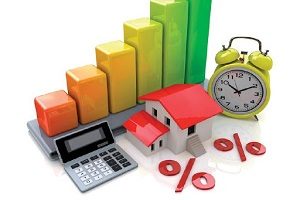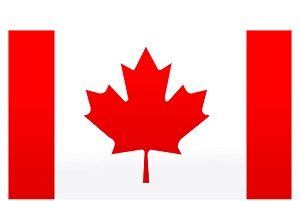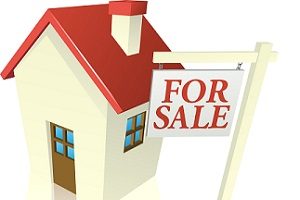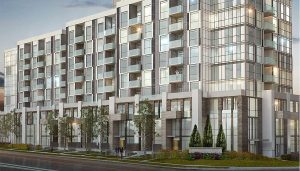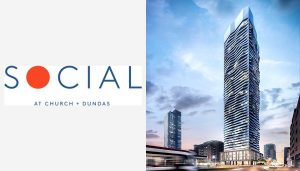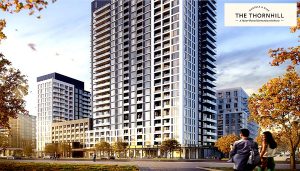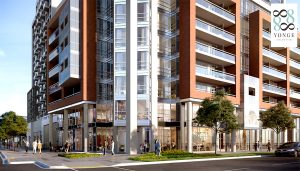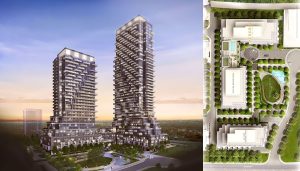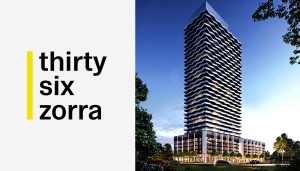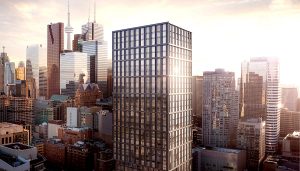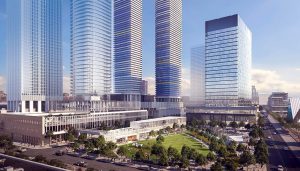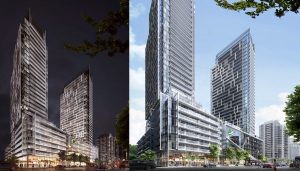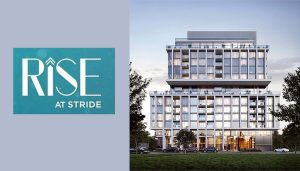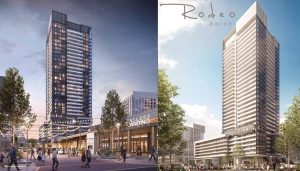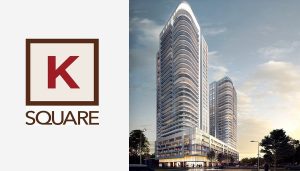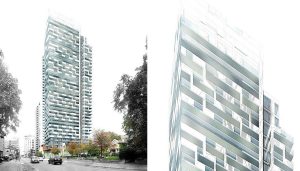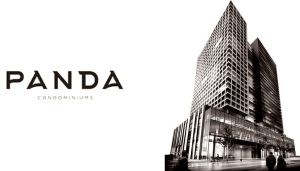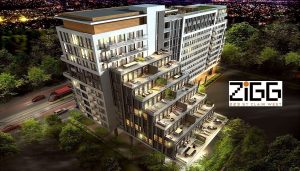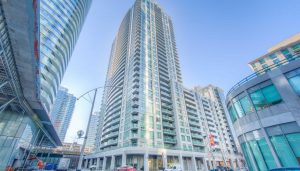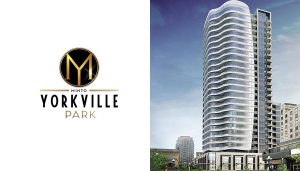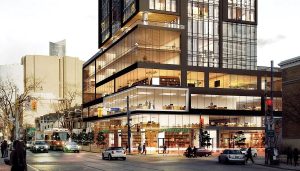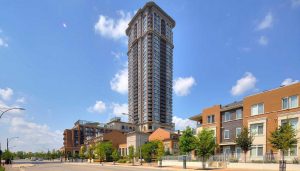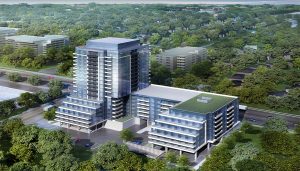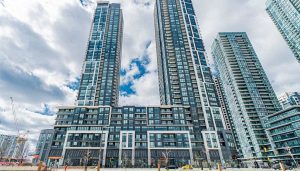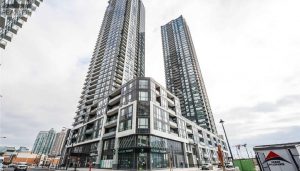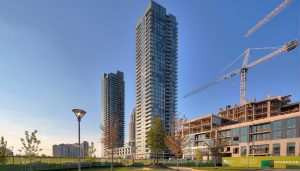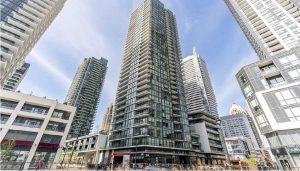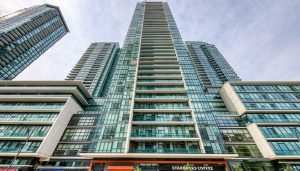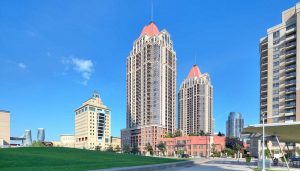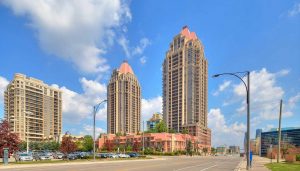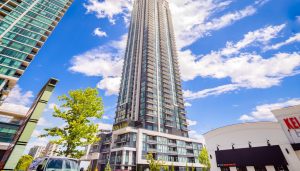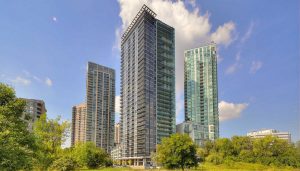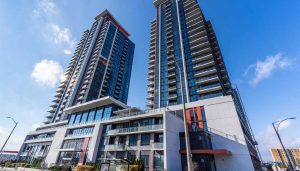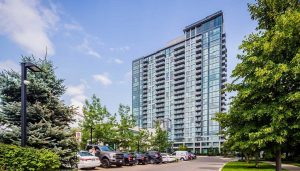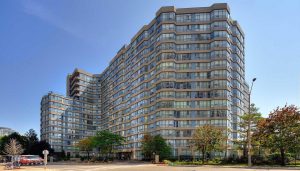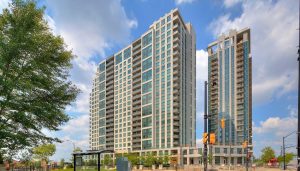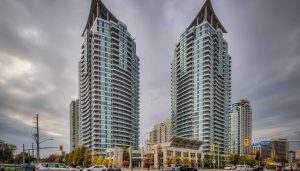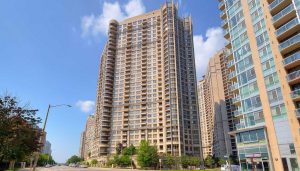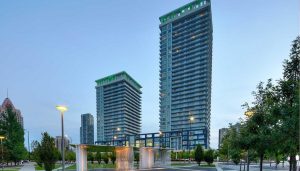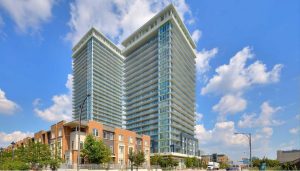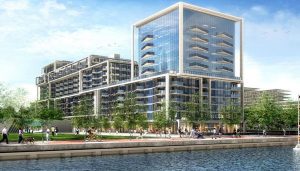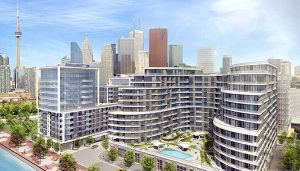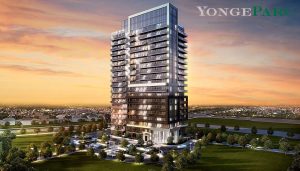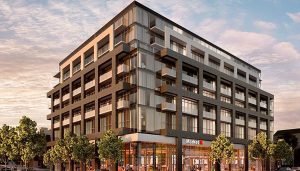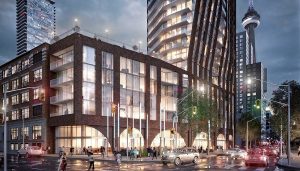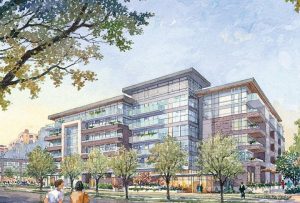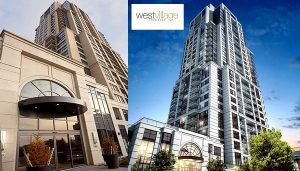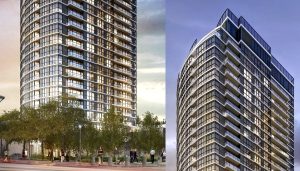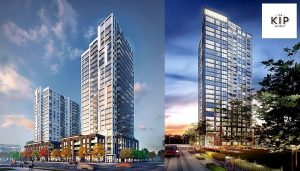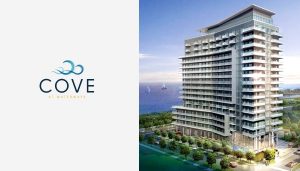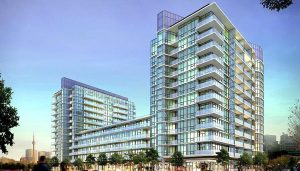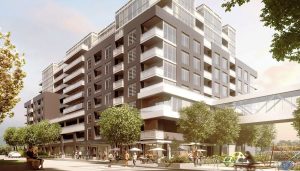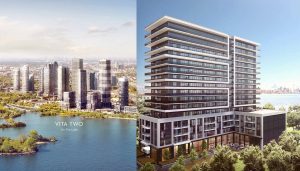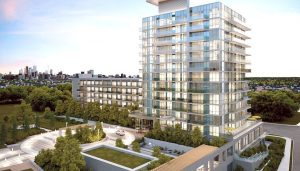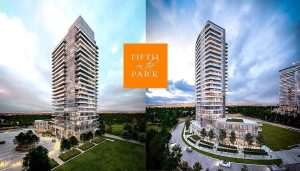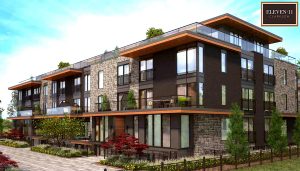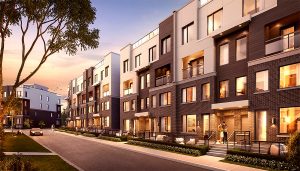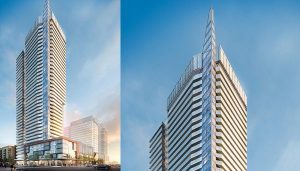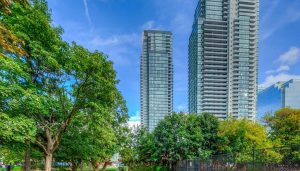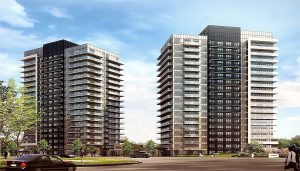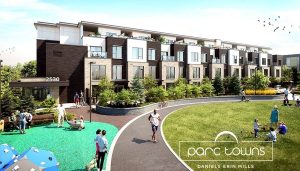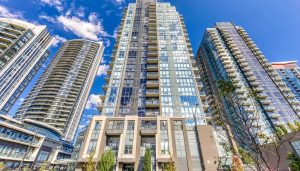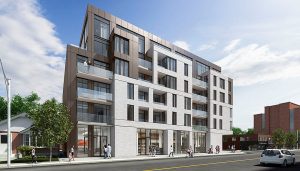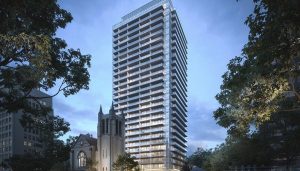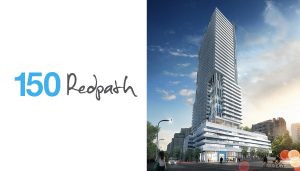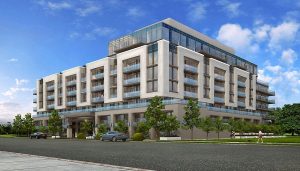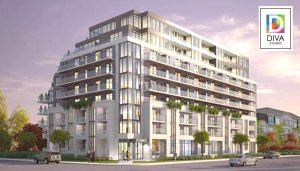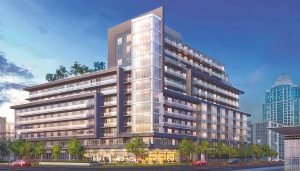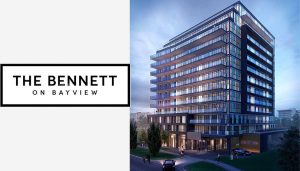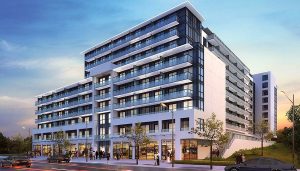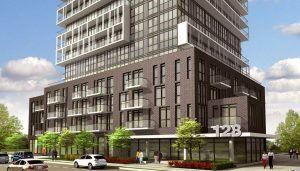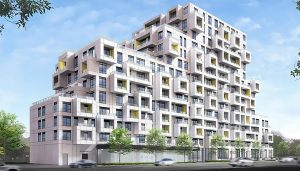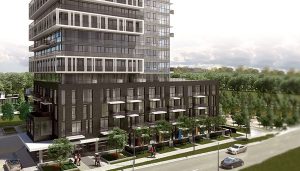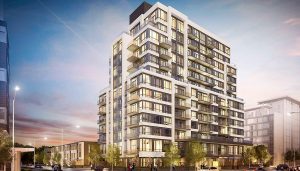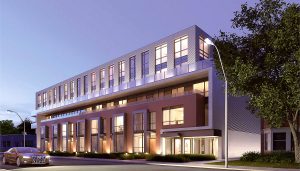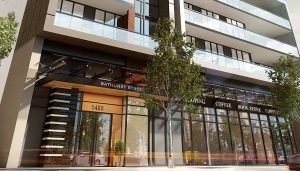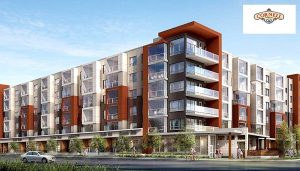加拿大商业地产术语(Commercial Terminology Glossary)
A
Abandonment
Results when a Lessee/Tenant leaves a demised premises before the end of a lease term and no longer fulfills or meets their obligations under lease.
Absorption
The net statistical change in total occupied space over a period of time. Positive absorption reflects an increase in occupied space while negative absorption reflects a decrease, usually expressed as a percentage rate. Accumulated Cost Recovery Total cost recovery deductions taken throughout the holding period of a property.
Acquisition Cost
The total cost to the purchaser of a property including soft costs and sales costs.
Additional Rents
Refers to items that a tenant may be charged for that are not included in usable square foot or other rent costs, but covers the taxation, maintenance and insurance of any common areas similar to TMI but relates to retail leasing and is usually defined.
Agglomeration Economies
Cost reductions or savings that come about from efficiency gains associated with the concentration or clustering of firms/producers or economic activities and the formation of a localized production network.
Amenities
These are features that make a property more attractive, useful, desirable and/or rentable and are usually taken into consideration when establishing the sale price or rent calculations.
Amortization
Payment of a debt as a sinking fund in regular, periodic installments of principal and interest, as opposed to interest-only payments.
Anchor Tenant
A prominent tenant (usually an established chain store/larger retailer such as Walmart or Canadian Tire) occupying a large proportion of a commercial property that draws traffic and attracts customers and other tenants to the property.
Annual Debt Service (ADS)
The total amount of principal and interest to be paid each year to satisfy the obligations of a loan contract.
Annual Percentage Rate (APR)
The true annual interest rate payable for a loan in one year taking into account of all charges made to the borrower including compound interest, discount points, commitment fees, and mortgage insurance premiums. It also takes into account the time at which the principal is repaid (especially when payments of principal are made in installments throughout the year but interest is charged at the beginning of the year), but not the actual expenses incurred by the lender in making the loan and recharged to the borrower.
Annuity
Regular fixed payments or receipts over a predetermined designated period of time.
Appraisal Estimate
An adequately supported written opinion prepared by a qualified appraiser of the market value of the real property as of a specified date that evaluates the real property rights, interests or benefits involved according to accepted appraisal practices.
Appreciation
An investment’s increase in value, usually expressed over time.
Appreciation Potential
The possibility or probability that a real estate investment will increase in value during the holding period.
Arrears
Money that is due or past due, but has not been paid.
Assessment/Assessed Values
(1) The estimating of value of property for realty tax purposes. (2) A levy against property in addition to general taxes, usually for improvements such as streets, sewers, etc. Assessed Values is the estimated value of real property established by the realty tax assessor (MPAC) for the purpose of levying real estate taxes that serves as the base for applying municipal/local realty taxes.
Assignment
An act of making a legal transfer of a right or liability from one entity to another.
B
Balloon Payment
A lump sum payment of the balance due on a partially amortized loan.
Base Rent (in lease terminology)
A face, quoted, dollar amount representing the rate or rent in dollars per square foot per year and typically referred to as the base rent. Base is also used in escalation clauses to calculate additional charges over and above base amounts as per the lease document.
Base Net Rent
The minimum rent due to the landlord. The rental rate not including inducements, taxes and operating costs. Can be used by a building owner as a reference with regard to building cash flow and value, taking into account any inducements or fees paid.
Bay
The rectangular/square opening between two columns, walls, etc., which delineates a room-like space. May be industrial space, parking space, barn space or other use and can be specified in dimensions (25 FT X 25 FT) or area (225 SF).
Bearing Wall
A wall which supports the weight of a part of a structure in addition to its own weight.
Blanket Mortgage
A mortgage covering more than one property of the mortgagor, such as a mortgage covering all the lots of a builder in a subdivision.
Book Value
The value of a property as a capital asset (cost plus additions to value, less depreciation). Accounting term: net book value = historical cost less accumulated depreciation.
Break-Even Point
The stage at which an investment produces an income that is just sufficient to cover recurring expenditures. For an investment in real property, the point at which gross income is equal to normal operating expenses, including debt service (the stage at which the next cash flow becomes positive). This is also known as the default point.
Breakpoint
The sales threshold over which percentage rent is due. It is calculated by dividing the annual base rent by the negotiated percentage applied to the tenant’s gross sales.
Build to Suit
The construction of a building or property that is designed and built to the particular needs of a prospective tenant or occupant.
Business Risk
The uncertainty associated with the possible profit outcomes of a business venture.
C
Common Area Maintenance (CAM)
This is the amount of additional rent charged to the tenant, in addition to the Base Rent, to maintain the common areas of the property shared by the tenants and from which all tenants benefit. Examples of common areas include elevators, elevator shaft, snow removal, outdoor lighting, parking lot sweeping, insurance, property taxes, lobbies, visitor washrooms, etc. Most often, this does not include any capital improvements that are made to the property and is defined in lease agreements.
CAM Cap
The maximum amount for which the tenant pays its share of common area maintenance costs. The owner pays for any CAM expenses exceeding that amount.
Cap Rate
See capitalization rate.
Capital Expenditures
Property improvements that cannot be expensed as a current operating expense for tax purposes. Examples include a new roof, improvements of a parking lot – such items are added to the basis of the property and then can be depreciated over the holding period. Distinguished from cash outflows for expense items such as new paint or plumbing repairs (operating expenses) that can be expensed in the year they occur. Also see operating expenses.
Capital Gains
Gains realized from the sale of capital assets. Generally, the difference between cost and selling price, less certain deductible expenses. Used mainly for income tax purposes.
Capitalization
Determining a value of income property using the annual net income (either known or estimated) and discounting by using a rate of return commonly acceptable to buyers of similar properties. For example, net income before income tax of a property is $10,000 per year. Capitalizing at a rate of 10 per cent, the property would be worth $100,000.
Capital Market
The supply and demand for resources to invest in real estate and other investments and is the forum in which capital assets are traded.
Capitalization Rate
A percentage that relates the value of an income producing property to its income, expressed as net operating income divided by purchase price and is also referred to as cap rate.
Cash Flow After Tax (CFAT)
For properties, it is the result of first calculating the net operating income, less mortgage and construction loan interest, less cost recovery for improvements and personal property, less amortization of loan points and leasing commissions to arrive at real estate taxable income. Next, real estate taxable income is multiplied by the applicable marginal tax rate to result in the tax liability (savings). Then, from the net operating income, annual debt service is subtracted to equal the cash flow before taxes (CFBT). Finally, the cash flow after taxes (CFAT) is calculated from the CFBT, less the tax liability (savings), plus investment tax credit. The Cash Flow Analysis Worksheet can be used to calculate a property’s gross operating income, net operating income, real estate taxable income and tax liability or (savings), CFBT, and CFAT.
Net Operating Income:
– Interest
– Cost recovery
– Amortization of loan points
Real Estate Taxable Income:
X Investor’s marginal tax rate
Tax Liability (savings)
Then:
Net Operating Income:
– Annual debt service
Cash flow before taxes:
– Tax liability (savings)
Cash flow after taxes
Cash Flow Before Tax/es (CFBT)
For properties, it is the result of calculating the effective rental income, plus other income not affected by vacancy, less total operating expenses, less annual debt service, funded reserves, leasing commissions and capital additions. The Annual Property Operating Data form can be used to calculate a property’s effective rental income, gross operating income, total operating expenses, net
operating income and cash flow before taxes.
Cash Flow Model
The framework used to determine the cash flow from operations and the cash proceeds from sale.
Cash-on-Cash Rate
A return measure that is calculated as cash flow before taxes, divided by the initial equity investment.
Cash Proceeds from Sale
The sales price less sales costs, mortgage balance, and tax liability on sale.
Consensus Metropolitan Area
Area consisting of one or more neighboring municipalities situated around a core. A census metropolitan area must have a total population of at least 100,000 of which 50,000 or more live in the core. A census agglomeration must have a core population of at least 10,000.
CFAT
See cash flow after tax.
CFBT
See cash flow before tax.
City
An urban settlement or system under a municipality government containing various functions, agents, institutions and components which interact and work together to satisfy the wants and needs of its inhabitants (as well as a portion of the population in surrounding rural areas) and its infrastructure and economic development.
Clear Height
The measurement in an industrial building between the floor and the lowest portion of the supporting structure of the building roof deck.
Clear Span
An interior area which does not use columns or posts to hold up the roof, thereby creating a large, open area with maximum visibility and use of the floor space.
Clear Title
Any property that is free of any and all competing claims, mortgages, liens and encumbrances.
CLOSE
The acronym CLOSE represents the contingencies, legal instruments, obstacles, signatures, and execution involved in the cost stage of a transaction pertaining to bringing parties together constituting an agreement.
Commercial Real Estate
Any multi-family residential, office, retail, land, industrial, sale of business with or without a property, that can be bought or sold in a real estate market.
Common Area
The areas of a building (and its site) that are available for the non-exclusive use and shared by all its tenants, such as lobbies, corridors, elevators, stairwells, washrooms and parking lots and for which the costs of maintaining same is shared on a pro-rata basis by all tenants.
Community Centre
Community Centres are public locations where members of a community tend to gather for group activities, social support, public information, and other purposes. They may sometimes be open for the whole community or for a specialized group within the greater community.
Comparable
A term used to refer to area rents or competitive rental properties or area sales that have sold, implying that “rent comparable” and “sales comparable” are comparable in size, location, condition, amenities, etc., to the subject property.
Comparative Advantage (Site Selection)
The principle that cities or regions tend to produce those items or support those activities for which they have the greatest advantage over other areas as defined by the factors of production, demand, supporting industries, and quality of life considerations, as defined in relation to human, financial, and physical resources and opportunity costs – costs expressed in terms of opportunities foregone.
Competition
A market condition or setting in which numerous firms compete for a share of any given market in a given geographic area; a term which is also used to denote rivals or competitors.
Compound Interest
Interest computed on the original principal and accumulated interest.
Compounding
A type of calculation in which interest earned is reinvested and earns additional interest.
Conditional Offer
When an offer to purchase or lease a property is subject to certain conditions, including the buyer’s approval of income and expense statements, title commitment, physical condition of the property, loan commitment, etc., being met. The specific amount of time allowed to clear these provisions is called the inspection or contingency period.
Condominium
A structure of two or more units, the interior space of which is individually owned; the balance of the property (both land and building) is owned in common by the owners of the individual units. The size of each unit is measured from the interior surfaces of the exterior walls, floors and ceiling. The balance of the property is called the common area.
Consolidation (Property & Financial Reporting)
The combining of assets, liabilities and other financial items of two or more entities into one. In the context of financial accounting, the term consolidate often refers to the consolidation of financial statements, where all subsidiaries report under the umbrella of a parent company. These statements are called consolidated financial statements. Consolidation also refers to the merger and
acquisition of smaller companies into larger companies. A consolidation, however, differs from a merger in that the consolidated companies could also result in a new entity, whereas in a merger, one company absorbs the other and remains in existence while the other is dissolved.
Contract Rent
The total rental obligation, expressed in dollars, as specified in a lease and can also be expressed as gross rent. Also known as base rent or minimum rent.
Cost
The actual dollar amount paid for a property, a business or any amount needed to build or improve it at a specified time.
Cost of Sale
The costs which may include, but are not limited to, items such as brokerage commissions and fees and any additional transaction costs that are incurred during the sale of the property.
Cost Approach
A real estate valuation method that surmises that the price someone should pay for a piece of property should not exceed what someone would have to pay to build an equivalent building. In cost approach pricing, the market price for the property is equivalent to the cost of land plus cost of construction, less depreciation. It is often most accurate for market value when the property is new.
Cost of Occupancy
Expenditures that are required to assume and maintain occupancy of a space. Such expenditures include rent, common area maintenance and/or mortgage payments, and recurring costs such as utilities, real estate taxes, repairs, operating expenses and other outgoings directly resulting from the use of the property.
D
Data
Refers to information collected and presented in a form that facilitates processing and analysis.
DDF™ (Data Distribution Facility)
Canadian Real Estate Association’s (CREA’s) DDF™ is an optional, permissionsbased system that enables Brokerage Owners and REALTORS® to send their listings to multiple third party websites using a console on REALTOR Link®, and receive ongoing feedback on the success of these web marketing efforts.
Debt-coverage Ratio (DCR)
Ratio of net operating income to annual debt service and is expressed as net operating income divided by annual debt service.
Deferred Losses
Passive losses that cannot be used in the current year are suspended for use in future years or at the time of sale.
Demand
The volume or quantity of products or services purchased, or willing to be purchased, in relation to price.
Demand Factors
Elements or forces that influence the demand for goods and services in a given market area.
Demographics
Characteristics of human populations as defined by population size and density of regions, population growth rates, migration, vital statistics, and their effect on socio-economic conditions.
Density
This is the amount of total square feet buildable on a parcel of land as defined by current zoning by-laws. For example, high density properties feature more floors.
Depreciation
1. Decrease in value to real property improvements caused by deterioration or obsolescence.
2. A loss in value as an accounting procedure to use as a deduction for income tax purposes.
Differential Cash Flow
The difference that results when the cash flows from one alternative are subtracted from the cash flows from another alternative.
Disaggregating Supply or Demand
The process of separating and identifying the various forces and factors which affect the supply/demand for a given property type in a given market or differentiation of supply/demand by category (Supply: including leased versus owned, unit type, price and geographic submarket; Demand: in reference to tenure, household income and geographic submarket).
Discount Rate
The percentage rate at which money or cash flows are discounted. The discount rate reflects both the market risk-free rate of interest and a risk premium.
Discounted Effective Rent
The cash flows over the term of the lease, discounted to present value.
Discounting
The process of reducing the value of money received in the future to reflect the opportunity cost of waiting to receive the money.
Displaced Sales
Sales that result from purchases made by customers who are not located in the subject service area (represents a revenue gain for retail establishments as sales are generated from consumers who reside outside the local trade area).
Diversification
A risk management technique that mixes a wide variety of investments within a portfolio.
DLA (Data License Agreement)
Agreement signed by a Brokerage authorizing TREB to allow a salesperson or third party to download only the Member’s or office’s or the Brokerage’s listings into his/her website.
Drive-time Approach
An approach to estimating the trade area (and sales/revenue potential) for a given retail establishment or centre based on the central place theory concept of range and how far people are willing to travel to obtain retail goods as defined by drive time.
Due Diligence
The process of an investigation or audit of a potential investment conducted by or for the potential lender or purchaser to reduce risk to validate the accuracy of the data. Generally, due diligence refers to the care a reasonable person should take before finalizing or completing an agreement or a transaction with another party.
E
Economic Base
Those economic activities or sectors in a local or regional economy that account for a certain share of the area’s income that is generated from exports of goods and services.
Economic Base Analysis
Inquiries that focus on the extent to which changes in basic employment (export-oriented activities and associated wage-income) affect the economic, employment and population growth of a local or regional economy.
Economic Base Multiplier
A measure that provides a rough estimate of how changes in basic employment will affect total employment in a given region (all other things being equal); defined as the ratio of total employment to basic employment.
Economic Characteristics
Attributes of the workforce, including production and employment activities.
Economic Obsolescence
The reduction in a property’s value due to external circumstances such as legislation or changes in the nearby property use.
Economic Sectors
Branches or divisions of a local or regional economy in which particular activities take place.
Economics of Scale
Cost reductions, savings, or advantages that come about from efficiency gains associated with increasing levels of production output or the increased size of an operation or system (as the average cost of production falls with increasing output or size).
Effective Amount
An amount after a base amount has been adjusted for concessions, allowances and costs.
Effective (Average Annual) Rate
The average total annual rent divided by a specific unit (sq. ft.) gives you the annual effective rate.
Efficiency
A measure of the capacity or effectiveness of space to produce the desired results with a minimum expenditure of time, money, energy and materials.
Elevation
(1) The exterior design of a structure, usually but not necessarily, viewed from the front is called a horizontal elevation. (2) Height measured from any point, such as elevation from a floor.
Employment Ratios
The percentage of total employees (at the firm or industry level) that are space users.
Encroachment
A building, part of a building or obstruction which intrudes on another property.
Encumbrance
A claim, lien, charge or other liability attached to real property which may diminish its net value.
Environmental Conditions
Features or state of the physical environment and the surroundings, factors or forces which influence or modify that environment.
Environmental Hazards
Any physical or natural condition or event which possesses a risk to humans.
Environmental Impacts
The repercussions of an activity or specific land use on the physical/social environment and traffic as a consequence of emissions, waste disposal, water and power usage, etc.
Equilibrium Point
The price at which the quantity supplied equals the quantity demanded.
Equity
The market value of real property, less the amount of existing liens and financing.
Equity Lease
A type of joint venture arrangement in which an owner enters into a contract with a user who agrees to occupy a space and pay rent as a tenant, but at the same time, receives a share of the ownership benefits such as periodic cash flows, interest and cost recover deductions and perhaps a share of the sales proceeds.
Equity Yield Rate
The return of the portion of an investment financed by equity capital.
Escalation Clause
A clause in a lease providing for an increased rental at a future time. May be accomplished by several types of clauses such as (1) fixed increase – a clause which calls for a definite, periodic rental increase. (2) cost of living – a clause which ties the rent to a government cost of living index, with periodic adjustments as the index changes. (3) Direct expense – The rent is adjusted according to changes in the expense of the property paid by the lessor, such as tax increases, increased maintenance costs, etc.
Expansion
A phase of the real estate or business cycle characterized by the dramatic shortterm increase in the supply of available units in a given market (due to economic growth and increasing construction activity) as a response to increasing and/or pent-up demand and rising price levels.
Expected Value (EV)
The sum of the weighted averages of all possible outcomes of a probability distribution. Probability distribution is the collection of all possible outcomes for an event and their corresponding probabilities of occurrence. The probabilities of occurrence for each possible outcome are used as the weights. The sum of each possible value multiplied by its probability of occurrence equals the EV of the outcome. EVs can be calculated for any type of outcome the investor chooses to analyze: net operating incomes, after-tax cash flows and rates of return (IRRs).
An example of calculating the EV of the IRR for an investment is as follows:
Scenario IRR% Probability Weighted Average
Best case 17.0 0.18 1.70
Most likely case 14.6 0.80 11.68
Worst case 13.2 0.10 1.32
Sum= 1.00 EV= 14.70
Expenditure Patterns
The tendencies or propensities of individuals/households to spend disposable income on a given good or service in comparison to other goods and services (typically defined as a percentage of disposable income) in relation to income level or range and/or other demographic or socio-economic characteristics.
External Economies
Savings or cost-cutting allowances realized by firms or industries within a given city that are primarily due to the advantages of sharing production inputs, information, and infrastructure and/or possibly linked to a city’s comparative advantage to support a given activity.
External Obsolescence
The loss of value due to external forces and change. For example, a new mall causes traffic and congestion, negatively affecting residential property values nearby; or a motel is no longer viable because a highway is rerouted; or another example would be depressed market conditions.
F
Fair Value of an Asset or Liability
The estimated value of all assets and liabilities of an acquired company used to consolidate the financial statements of both companies.
Fashion/Specialty Centre
This type of retail centre is composed mainly of upscale apparel shops, boutiques and craft shops carrying selected fashion or unique merchandise of high quality and price. These centres need not be anchored, although sometimes restaurants or entertainment can provide the draw of anchors. The physical design of the centre is very sophisticated, emphasizing a rich décor and high quality landscaping. These centres are usually found in trade areas having high income levels.
Feasibility Analysis
The process of evaluating a proposed project to determine if that project will satisfy the objectives set forth by the agents involved (including owners, investors, developers and lessees).
Financial Leverage
The use of borrowed funds to acquire an investment.
Financial Risk
The possible change in an investment’s ability to retain or return principal and income.
First Right of Refusal
An option provided to a tenant in a lease contract providing first right to occupancy space or match an incoming offer on adjacent space considered required for the tenant’s future expansion. May also apply to a purchase option.
Fixed Expenses
Costs that do not change with a building’s occupancy rate. They include property taxes, insurance and some forms of building operating costs and maintenance.
Fixed Lease
A lease in which the lessee pays a fixed rental amount for the term of the lease.
Flex Space
Space that is flexible in terms of what it can be used for, for example, space that could be utilized for industrial or office activities. Commercial space that can be used for a variety of purposes such as multiple-use office space.
Forecast
An estimate or prediction of a future condition or outcome over a set period of time.
Free and Clear
Real Property against which there are no liens, especially voluntary liens (mortgages).
Free Rent
A period of free rent given to the tenant by the lessor as an inducement.
Free Standing Building
A structure which does not depend on other structures for support, an independent structure and intended as a single tenant use.
Fully Amortized Mortgage Loan
A method of loan amortization in which equal payments completely repay the loan over a fixed period of time.
Functional Feasibility
Considerations made in the site selection process which assist in the evaluation of site potential as defined in terms of the practicality of a site, the best site for a given use, or the determination of a site’s best use, through examination of components, data, linkages, competition, demographics and market conditions.
Functional Obsolescence
A reduction in the usefulness or desirability of an object or property, because of an outdated design feature, usually one that cannot be easily changed.
Future Value (FV)
The value of an asset or cash at a specified date in the future that is equivalent in value to a specified sum today. There are two ways to calculate FV:
1. For an asset with simple annual interest: = Original Investment x(1+(interest rate* number of years))
2. For an asset with interest compounded annually: Original Investment x(1+(interest rate)^number of years)
G
General Market Factors
Factors influenced by the demographic, economic and locational characteristics and the organizational aspects of a market as it relates to supply and demand.
Geographic Information System(s) (GIS)
System(s), usually computer-based, used for capturing, handling, storing, retrieving, managing, manipulating and displaying geographic information or geo-coded data.
Geographic Submarket
The total number of households or housing units within a given area as defined by tenure, income and other socio-economic attributes that are known to exist or estimated to be within specific geographic units or divisions, for example, in various census tracts.
Globalization
The condition of being or becoming globalized. A concept used to recognize cross-jurisdictional interdependencies and the continuing integration of local, regional and national economies which now form a larger economic and production system that is worldwide in scope and application; a trend that has greatly affected local economic change and real estate values.
Government Incentives
Concession given or measures taken by local or regional government to attract firms or investment dollars to a given locality for the purposes of promoting economic growth and encouraging development.
Graduated Lease
A lease calling for a varying rental, usually based on periodic appraisal or simply the passage of time.
Gross Area
The entire floor area of a building or the total square footage of a floor.
Gross Leasable Area (GLA)
The total floor area designed for tenant occupancy and exclusive use (and can include basements, mezzanines and upper floors), measured from the centre line of joint partitions and from outside wall faces. GLA is that area on which tenants pay rent. (Also see useable area and gross-up factor.)
Gross Lease
A lease which obligates the lessor to pay all or part of the expenses of the leased property, such as taxes, insurance, maintenance, utilities, etc.
Gross Up Area
That portion of a tenant’s leased space, generally in a multi-tenanted or multistory building that is leased but not occupied by the tenant. This area is paid for by the tenant as common expenses and net rent may include such areas as washrooms, lobby area and utility centres.
Gross Operating Income
The total income generated by the operations of a property before payment of operating expenses. It is calculated from potential rental income, plus other income affected by vacancy, less vacancy and credit losses, plus other income not affected by vacancy. The Annual Property Operating Data form or the Cash Flow Analysis Worksheet can be used to calculate a property’s gross operating income.
Gross Rent Multiplier (GRM)
A method investors may use to determine market value. This method calculates the market value of a property by using the gross rents an investor anticipates the property will produce at end of year 1 multiplied by a given factor (known as the gross rent multiplier extracted from the marketplace).
Ground Lease
A lease of the land only. Usually the land is leased for a relatively long period of time to a tenant that constructs a building on the property. A land lease separates ownership of the land from ownership of buildings and improvements constructed on the land.
H
Heavy Utility Needs
In reference to location-decision considerations made in relation to the energy or power requirements of a firm/user in the assessment of the feasibility of a location to support a given activity.
Highest and Best Use
The use of land which will bring the greatest economic return over a given time by examining the profitability of all possible use scenarios.
Household
A housing unit or residence at a given location that is occupied by one or more persons (that is, a social unit comprised of one or more individuals living together in the same dwelling or place).
Household Population
The total number of households in a given geographic market or submarket as defined by specific demographic and socio-economic characteristics.
Housing Demand
The total number of housing units demanded in a given market, due to increase in population and declining vacancy.
I
IDX (Internet Data Exchange)
Allows Brokerages, through reciprocal agreements, to display each other’s listings on their websites through permissions.
In-migration
The process by which a given geographic area absorbs new individuals/households from locations outside that area (an influx of individuals/households to a given area).
In-the-Door Approach
An approach to estimating the trade area (and sales/revenue potential) for a given retail establishment or centre based on observed flow patterns or traffic counts, where estimates are obtained for both the percentage of traffic that stops or patronizes that establishment/centre and the percentage of people coming in-the-door who make a purchase.
Income Capitalization Approach
A method to estimate the value of an income-producing property by converting net operating income into a value. The cap rate is divided into the net operating income to obtain the estimated value. Value = net operating income divided by capitalization rate.
Index Lease
A lease in which the rental amount adjusts accordingly to changes and/or movements in a price index, commonly the consumer price index.
Industrial Location Decision-Making
A decision-making process that involves the examination and evaluation of alternative locations or sites for a particular industrial activity based on location/site feasibility characteristics. Great importance is placed on the national or regional location decision (usually narrowing the location decision to a handful of cities or localities), with less importance given to the local site selection process (refer to site selection).
Industrial Property/Service Area
Commercial properties that are zoned industrial for the purposes of production, manufacturing, warehousing or distribution, etc., or the necessary services and resources needed to support a given industry activity or facility.
Initial Investment
The outlay of funds needed to acquire an investment.
Input-Output Modeling
A mathematical approach to the description of a local or national economy, which takes explicit account of the flows and linkages within and between economic sectors. Recognizing that output (products and services) from one sector may require production inputs for other sectors, used to estimate sectorand-region-specific multipliers for the purpose of analyzing the direct and indirect impacts of a given change in a particular sector or region.
Insurable Value
Replacement cost or actual cash value of a building for which standard insurance policies provide indemnity cover. Insurable value is less than the property’s appraised or market value because it excludes the value of land on which the building stands. The formula for computing the insurable value is usually stated in the valuation clause of a policy document.
Intangible Characteristics
Attributes that are not directly measurable or quantifiable, and therefore must be expressed in a qualitative or abstract manner.
Interest-Only Mortgage
A mortgage under which the principal amount borrowed is repaid in one
payment upon maturity. Periodic interest payments are made.
Internal Rate of Return (IRR)
The internal rate of return (IRR) or economic rate of return (ERR) is a rate of return used in capital budgeting to measure and compare the profitability of investments.
Inventory
The supply or quantity of stock of a given commodity, produce or raw materials.
Investment
Investment is putting money into something with the expectation of gain, usually over a longer term. Most or all forms of investment could involve some form of risk.
Investment Value
The value to a specific investor, based on that investor’s requirements, tax rate, financing or expected rate of return.
L
Labour Pool
A body or core group of workers (employed and employable) that make up the available local labour force.
Landlord
The owner or lessor of the property being leased.
Landlord-Paid Tenant Improvements (LPTI)
The total cost (outlay) of necessary tenant improvements provided or allowed by the landlord netted against any contribution made by the tenant.
Land Sale-Leaseback
The same concept as a sale-leaseback, but only the land is sold and leased back using a ground lease.
Loss of Retail Patronage
Purchases made in other service areas by consumers located within the subject area (representing a loss of revenue for retailers located within the trade area in which those consumers reside).
Lease
A contract that creates the relationship of landlord (lessor) and tenant (lessee). A contractually binding agreement that grants a right to exclusive possession or use of a property, usually for a set term for a periodic payment called rent.
Lease Buyout
The process by which a landlord, tenant or third party pays to extinguish the tenant’s remaining lease obligation and rights under its existing lease agreement. Alternatively, the offering by a new landlord to take over the current lease commitments of a tenant as an inducement to move to a new longer term lease elsewhere.
Leasehold Estate
In exchange for rent, the tenant has the right to occupy and use the property for the duration of the lease which then becomes a value to the tenant of the lease.
Leasehold Interest
Claim or right to enjoy the exclusive possession and use of an asset or property for a stated definite period, as created by a written lease. A long-term lease interest is a valuable asset in its own right which can be traded or mortgaged as a physical asset.
Leasing
A means of obtaining the physical and partial economic use of a property under a separate agreement without obtaining an ownership interest.
Letter of Intent
A formal method of stating that a prospective purchaser, buyer or lessee is interested in acquiring a property and outlines the terms to make an acquisition. It is not an offer and creates no obligation.
Lessee
The company or a person renting or leasing the property. Also known as a tenant.
Lessor
The owner or a person who rents or leases a property to another. Also known as a landlord.
Leverage/Financing
The use of borrowed funds to finance a portion of the cost of an investment.
Lien
A hold or claim one entity has upon property of another as security for a debt, charge, tax or judgment.
Liquidation Value
Usually a forced disposal of an asset. The likely price that a property would bring in a foreclosure or tax sale. Used when a sale must occur with limited exposure time to the market or with restrictive conditions of sale often referred to as a power of sale by a lender.
Liquidity
The ability to convert an investment into cash quickly, subject to market conditions and the possible risk of a loss of principle.
Loan Balance
The amount of money remaining to be paid on an amortizing loan at a given time.
Loan or Mortgage Value
That portion of the value of real property recognized by the lender when used to secure a loan.
Loan-to-Value Ratio (LTV)
The amount of money borrowed in relation to the total market value of a property. Expressed as the loan amount divided by the property value.
Lower Order Good
A good or service requiring a low threshold population to be offered. A good or service is considered to have a low threshold if it does not require a large number of consumers to support its business and thus requires a small trade area.
M
Macro/Micro Economics
Microeconomics is the study of decisions that people and businesses make regarding the allocation of resources and prices of goods and services. This means also taking into account taxes and regulations created by governments. Microeconomics focuses on supply and demand and other forces that determine the price levels seen in the economy. For example, microeconomics would look
at how a specific company could maximize its production and capacity so it could lower prices and better compete in its industry.
Macroeconomics, on the other hand, is the field of economics that studies the behavior of the economy as a whole and not just on specific companies, but entire industries and economies. This looks at economy-wide phenomena, such as Gross National Product (GDP) and how it is affected by changes in unemployment, national income, rate of growth and price levels. For example,
macroeconomics would look at how an increase/decrease in net exports would affect a nation’s capital account or how GDP would be affected by the unemployment rate.
Management
Management in all business and organization activities is the act of coordinating the efforts of people to accomplish desired goals and objectives using available resources efficiently and effectively. Management comprises planning, organizing, staffing, leading or directing, and controlling an organization (a group of one or more people or entities or effort) for the purpose of accomplishing a
goal. Resourcing encompasses the deployment and manipulation of human resources, financial resources, technological resources and natural resources.
Managing Risk
The process of identification, analysis and either acceptance or mitigation of uncertainty in investment decision-making. Essentially, risk management occurs anytime an investor or fund manager analyzes and attempts to quantify the potential for losses in an investment and then takes the appropriate action (or inaction) given their investment objectives and risk tolerance. Inadequate risk management can result in severe consequences for companies as well as individuals.
Marketability
Marketability deals with the appeal and demand for properties, goods or services.
Market Area
A geographic area in which supply and demand operate to influence the course of industrial and commercial business activities.
Market Adjustments
A change in market parameters or conditions brought about in response to one or more market signals (including price changes from shifts in supply and demand); typically characterized as cycles, fluctuations or trends (categories that differ in terms of cause, duration and impact on commercial real estate markets).
Market Analysis/Feasibility
The process of examining market supply and demand conditions, demographic characteristics and opportunities; identifying alternative locations/sites that meet specific objectives or satisfy various criteria, and assessing the financial feasibility of those locations/sites to facilitate decision making regarding the commercial potential or suitability of various locations/sites to support a given activity or a site’s highest and best use.
Market Data
Information/data available, collected and displayed for a given market or market area.
Market Data Approach
A method of determining the property’s value by analyzing recent sales or rental prices of similar or comparable properties or similar comparable areas. The pricing of commodities (including rental rates of various types of commercial properties) as determined by the forces and factors of influence operating in a market.
Market Dynamics
In reference to changing market conditions and the underlying processes responsible for creating change and defining/redefining interrelationships amongst components in an economic system (consider the change in price levels of a given commodity as an outcome of the forces and interplay of supply and demand).
Market Risk
The possibility that downward market trends will reduce an investment’s market value.
Market Share
Refers to the percentage of total sales in a retail category that each competing outlet is expected to capture based on current patterns and trends in the market.
Market Strategy
A course of action defined with respect to a particular real estate market phase. For example, consider the market strategy of avoiding real estate transactions when there is an oversupply of space available in the market.
Market Value
The most probable price that a property would bring in a competitive and open market under equitable and fair sale conditions. Market value also refers to an estimate of this price.
Market Value Re-Assessment
The updating by municipality of the total municipal assessment base (total value of all properties) to a more current calculation of value.
Mean
A measure of central tendency (for a distribution of values) defined as the average value of a variable in a sample and calculated by adding together all the values observed in a data set and dividing by the number of values observed.
Median
Defined as the middle value of a data set (or sample) when the values are
arranged in order (by size ranking, in ascending or descending order). Note that for an odd number of values in an ordered data set, the median is identified as the value which divides the data set into two data sets of equal size on each side of the median or middle value. For an even number of values arranged in order, the median is found by simply calculating the value mid-way between the two middle values. Note that the position of the median value of an ordered data set containing n observations may be found by using the formula: position of the median = n/2 + ½.
Mill
Equal to one tenth of a cent. Used in expressing a tax rate. Ten mills would be the same as ten dollars per thousand.
Mortgage
A debt instrument, secured by the collateral of specified real estate property, that the borrower is obliged to pay back with a predetermined set of payments.
N
Negative Cash Flow
When the income from an investment property does not equal the usual expenses. The owner must come up with cash each month to meet these expenses.
Negative Leverage/Neutral Leverage
Borrowed funds are invested at a rate of return lower than the costs of funds to the borrower. An investment situation in which the cost of borrowed funds is exactly equal to the yield provided by the investment.
Neighbourhood Centre
This centre is designed to provide convenience shopping for the day-to-day needs of consumers in the immediate neighbourhood. A neighbourhood centreis usually configured as a straight-line strip with no enclosed walkway or mall area, although a canopy may connect the storefronts.
Net Effective Rent
It is the rent received after leasing costs (commissions and allowances) are given out. Landlords often keep the Advertised Rate higher to benefit them to maximize their income, which potentially allows them to sell the property for a higher price or obtain a larger loan if retaining the property.
Net Lease
A lease in which the tenant pays, in addition to base rent, all operating expenses such as real estate taxes, insurance premiums and maintenance costs, as well as all utilities.
Net-net Lease
A lease in which the tenant pays a rent to the landlord that includes all real estate taxes only and does not include any portion of the operating expenses.
Net-net-net Lease
Also known as a triple net lease, which the tenant pays rent to the landlord that does not include all property taxes and operating expenses.
Net Operating Income (NOI)
The rental income plus other income, less vacancy, credit losses and net operating expenses.
Net Present Value (NPV)
A mathematical method of comparing various lease options, e.g., inducements, free rent, build out allowances and escalating lease rates presented to a tenant by calculating the total occupancy cost over the term of the lease. By taking into consideration inflation and financing rates, a net effective value lease rate in today’s dollars can be calculated.
Net Rentable Area
Also known as net rentable square feet. This is the total amount of square feet that can be used for rental income. It typically excludes stairways, elevators, hallways, common areas, etc.
Net Rent Multiplier
The factor resulting from dividing the net operating income into the sale or purchase price.
Non-Conforming Use
Property used for purposes that do not confirm to the permitted uses in the municipal or provincial zoning by-laws due to zoning that has been altered or changed pursuant to the original occupancy.
Non-household Population
That portion of the total population that is not considered to be part of the local residential housing market; composed of individuals living in dormitory-like facilities (including military bases) or institutional settings (such as students in residential halls).
O
Obsolescence
In reference to the inadequacy, disuse, outdated or non-functionality of facilities, infrastructure, products or production technologies due to effects of time, changing market conditions or decay (a factor considered in depreciation).
Occupancy Cost
The actual dollars paid out by the tenant to occupy the space, which will include but not be limited to rent taxes, maintenance, insurance and utilities.
Office
Low-Rise: Fewer than seven stories high above ground level;
Mid-Rise: Between seven and twenty-five stories above ground level;
High-Rise: Higher than twenty-five stories above ground level.
Office Property
A commercial property type used to maintain or occupy professional or business offices. Office space that can be used for a variety of purposes is sometimes referred to as generic office space. Office properties may be classified as Class A, B or C. Class A properties are the most functionally modern. Properties Classed B and C in the same market typically command lower rents because they are older and in need of modernization. They may not be as efficient or desirable as Class A properties because their design or condition causes functional problems. Office space is also available in free stand, condominium or residential style buildings.
On-site Improvements
Work completed on a property that improves its value.
Opportunity Cost
The costs of an alternative that must be forgone in order to pursue a certain action. The difference in return between a chosen investment and one that is necessarily passed up.
Operating Expenses
Cash outlays necessary to operate and maintain a property. Examples of operating expenses include real estate taxes, property insurance, property
management and maintenance expenses, utilities and legal and accounting expenses. Operating expenses do not include capital expenditures, debt service
or cost recovery.
Option
The right within an agreement to purchase or lease a property or an adjoining property under specific conditions.
Out-migration
The process by which a given geographic area expels or loses individuals/households to locations outside that area (an out flux of
individuals/households from a given area).
Outlet Centre
A retail property type usually located in rural or occasionally in tourist locations, outlet centres consist mostly of manufacturers’ outlet stores selling their own brands at a discount. These centres are typically not anchored. A strip configuration is most common, although some are enclosed malls and others can be arranged in a village cluster, e.g., Power Centres.
Oversupply
A phase of the real estate market cycle denoting that period of time in which commercial real estate markets become saturated with units due to overbuilding or a depletion of tenancies resulting in an upward spike in vacancies.
Owning
A means of obtaining an ownership interest and total control which grants the full economic use of a property for the duration of the ownership.
P
Payback Period
The time required for the complete recovery of an investment; often used with the concept that all income is considered a return of capital until the entire investment is recaptured, and that income received after complete payback is considered profit.
Percentage Lease
A percentage lease is a lease where the rental is based on a percentage of the monthly or annual gross sales made on the premises, usually coupled with a base rent. This is a common lease type for retail stores operating in leased spaces, where the tenant pays a base rent regardless of profits/losses plus a percentage of revenue earned as a result of conducting business on the premises.
Phase I Level Audit
Generally refers to an initial environmental assessment of a facility by a qualified environmental engineering firm for potential contamination to determine if further investigations are warranted. This may include visual inspection, staff interviews and review of company operations and documents. Also done is a study of previous users of the property and neighbours for compliance of environmental regulations. Phase II Level Audit Investigations would require further subsurface sampling, electromagnetic and hydrogeological study.
Physical Depreciation or Deterioration
A form or source of accrued depreciation considered in the cost approach to market value. The physical decay or deterioration of a property that may result from breakage, deferred maintenance, effects of age on construction material, and normal wear and tear. (Barren’s Dictionary of Real Estate Terms)
Physical Limitations
Limitations imposed by the physical size, shape, or characteristics of a property or its level of development.
Planned Additional Inventory
In reference to commercial real estate, it is the supply or stock of a specific type of commercial unit or the amount of space that will be available in an upcoming forecast period from expansions, conversions (in), and new construction.
Planned Removed Inventory
In reference to commercial real estate, it is the supply or stock of a specific type of commercial unit or the amount of space that will not be available in an upcoming forecast period due to demolitions and conversions (out).
Population/Expenditure Approach
An approach to estimating the trade area (and sales/revenue potential) for a given retail establishment or centre based on the minimum area (or threshold population) that would be required to sustain a business, by calculating the population necessary to support total square footage of both existing and proposed space for a specific-use and determining/mapping the extent of the trade area based on population density.
Population Growth
The rate at which a given population base in a given geographic area is growing (positive or negative) in relation to the forces of internal growth, in-migration, and out-migration; a factor that is widely acknowledged as having the greatest impact on the demand for housing.
Population Migration
The movement and relocation of people from one place of residence to another in response to social and economic factors and forces; a long-term trend that can be expected to affect local economies and real estate values.
Portfolio Income
Income from interest, dividends, royalties or the disposition of property held for investment.
Positive Leverage
Borrowed funds are invested at a rate of return higher than the cost of the funds to the borrower.
Potential Rental Income
The total amount of rental income for a property if it were 100 percent occupied and rented at competitive market rates.
Power Centre
This retail centre is dominated by several large anchors, including discount department stores, off-price stores, warehouse clubs, or category killers – stores that offer tremendous selection in a particular merchandise category at low prices. The centre typically consists of several freestanding (unconnected) anchors and only a minimum amount of small specialty tenants (commonly referred to as a Big Box Centres).
Power of Sale
Legal mechanism by which a secured lender may sell a property to recoup monies owed.
Pre-lease
The leasing of a property or space that has not been developed or constructed.
Present Value (PV)
The sum of all future benefits or costs accruing to the owner of an asset when such benefits or costs are discounted to the present by an appropriate discount rate.
Price
The dollar amount that was offered, asked or actually paid for a property.
Primary Source Data
Information obtained directly from field observations and survey instruments (by observing or monitoring a phenomenon or site firsthand), typically involving quantitative measurement and/or qualitative assessment of that which is observed or monitored.
Principal Reduction
The portion of a loan payment used to reduce the original loan amount.
Production
Any economic activity that alters, enhances or transforms a product or material, thereby increasing the value of that product or material by changing its physical form and/or location.
Pro Forma
Means “for form only”. A study prepared to estimate future income, expenses and potential profit or loss.
Property Data
Property/site-specific information obtained from primary and secondary sources.
Property Market
The supply and demand for ownership interests in property.
Property-Specific Factors
Factors influenced by the site-specific and technical characteristics
Property Type
The classification of real estate based on its primary use. Property types are retail, industrial, office, multi-residential, land, recreational, hotels, special purpose, residential, etc.
Proprietary Data
Information obtained (usually at a cost) from private sources for firms that hold the exclusive rights to manufacture and distribute information created for specific applications, supplying business, sales and market-potential data and other information services to a targeted audience.
Purchasing Power Risk
The variability in the future purchasing power of income received from an investment.
Q
Qualify
Be entitled to a particular benefit or privilege by fulfilling a necessary condition.
R
Radius Clause
In a percentage lease, it is customary to have a clause that details the distance from the property that a competing store from the same chain may be located. This is usually a distance sufficient so that two stores from the same chain are not in the same trade area.
Range
The maximum distance consumers are willing to travel to purchase a good or service from a given establishment or location. Hence, the boundary or outer limits of the market area circumscribed about a location at which a good or service may be purchased can be easily identified having knowledge of the range.
Rate of Return
The percentage return on each dollar invested (also known as yield).
Real Estate Cycles (phases)
The regularly repeating sequence of economic downturns and upturns and associated changes in real estate market transactions tied to market dynamics and macro-economic conditions, whose phases include (in order) recession, recovery, expansion and oversupply.
Real Estate Fluctuations
Short-term variations in real estate prices or rents (could vary anywhere from one day to a few months to years) caused by natural hazards (such as tornadoes, hurricanes, floods, earthquakes and wildfires) or boosts or shocks to the local economy (such as the entry or exit of major employers).
Real Estate Investment Trust (REIT)
An investment vehicle in which investors purchase certificates of ownership in the trust, which in turn invests the money in real property and then distributes any profits to the investors. The trust is not subject to corporate income tax as long as it complies with the tax requirements for a REIT. Shareholders must include their share of the REIT’s income in their personal tax returns.
Real Estate Trends
Long-term movements or tendencies in the demand for real estate (which can typically last for years or decades), usually tied to macro-economic or business cycles.
REALTOR.ca
Website owned and managed by the Canadian Real Estate Association. TREB sends listings data to CREA to update this website daily.
Receiver
The individual or firm appointed by the creditors of an insolvent company to manage and disburse the assets as required.
Recession
A significant decline in activity across the economy, lasting longer than a few months. It is visible in industrial production, employment, real income and wholesale-retail trade. The technical indicator of a recession is two consecutive quarters of negative economic growth as measured by a country’s gross domestic product (GDP).
Recovery
A period of increasing economic activity or a general economic upturn, typically following a stabilization of key sectors and industries, marked by increasing sales and recovering prices in real estate markets as a direct result of an external shock (for example, a favorable tax code revision), or an increase in demand for commercial real estate which, in turn, leads to the absorption of excess space.
Regional Centre
A typical regional centre is usually enclosed with an inward orientation of the stores connected by a common walkway and parking surrounds the outside perimeter. Its main attractions are its anchors: traditional, mass merchant, discount department stores, or fashion specialty stores.
Regulatory Requirements
In reference to land use, they are restrictions or guidelines on development or use of land, properties, or facilities as defined in accordance with design standards, building construction requirements, land use plans, occupancy codes and zoning classifications as determined by the controlling or governing parties at the municipal or county levels.
Rent Concession
A defined period of free rent provided to the tenant by the lessor under terms specified within the lease.
Rentable Area
The computed area of a building as defined by the guidelines of Building Owners and Managers Association (BOMA) and typically measured in square feet, including both core/structure and useable area. The actual square foot area for which the tenant will pay rent. It is the gross area of an office building, less uninterrupted vertical space (such as stairways and elevators). Unlike useable area, rentable area includes common areas such as lobbies, restrooms and hallways as well as the measurement of structural columns and architectural projections.
Rentable-to-Useable Ratio
Defined as rentable area divided by useable area. Also known as the gross-up factor. Also see efficiency percentage.
Rent Escalators
Items specified in a lease such as base rent, operating expenses, and taxes that may increase by predetermined amounts at stated intervals or by a constant annual percentage. Also see index lease and expense stop.
Replacement Cost
The estimated cost to construct, at current prices, a building with utility equivalent to the building being appraised, using modern materials and current standards, design and layout. (Appraisal Institute)
Residential Property
Single or multifamily housing units that are used, serve or are designed specifically for residential purposes.
Retail
The sale of goods to the public in relatively small quantities for use or consumption rather than for resale.
Retail Gap Analysis
A gap analysis performed specifically on retail floor space in a given market or trade area.
Retail Premises
Premises used for the sole purpose of selling goods and/or services to the general public.
Retail Trade Area
Also referred to as service area, is generally defined as the geographic or formal area from which a sustained patronage is attracted to support a retail centre or establishment, the extent to which is determined by numerous factors including the site characteristics of the centre or establishment, its accessibility, the presence or absence of physical barriers to movement, and general limitations imposed by driving time, congestion and distance/separation.
Reversion Value
The reversion is the future cash benefit that the investor will receive upon sale of the subject property.
Risk Factor
The probability that actual cash flows from an investment will vary from the forecasted cash flows.
S
Sale-Leaseback
A leasing and financing strategy in which a property owner sells its property to an investor, then leases it back. This strategy frees capital that otherwise would be frozen in equity. Although the lease actually follows the sale, both are agreed to as part of the same transaction.
Sale(s) Proceeds After Tax
The sale proceeds before tax minus the tax liability on the sale.
Sale(s) Proceeds Before Tax
The sale price minus the sales costs and the mortgage loan balance.
Sales Comparison Approach
A way to determine market value by comparing a subject property to properties with the same or similar characteristics and within the same market and timeframe.
Sales Comparison Value
An estimate of value derived by comparing the property being appraised to similar properties that have been sold recently, applying appropriate units of comparison and making adjustments to the sales prices comparable based on the elements of comparison.
Sales Per Square Foot
Sales revenue generated per leasable square foot of retail floor space.
Sales Potential
The possible or expected revenue of a retail outlet as defined by conditions within the market or trade area and the forces of competition.
Sales Volume
The total amount of sales/revenue generated by a retail outlet or facility in a given time period.
Sample
A subset of a statistical population (typically selected randomly).
Sampling
The practice of obtaining a sample from a given statistical population.
Secondary Source Data
Information obtained from second-party or archival sources.
Security Deposit
Commonly a deposit of money from a tenant to a landlord to secure performance of a written or oral rental agreement which is usually in addition to normal
deposit on a transaction.
Securitization
The phenomenon of indirectly investing in real estate markets in ways that minimize risk (for example, investments made collectively with pooled money or
the use of investment packages/funds, such as mortgage backed securities sold on the secondary financial market) as opposed to direct investments where investors own property or hold mortgages; a long term trend that has had significant impact on real estate values.
Service Area
The geographic area that encompasses/delineates the principal share of clients or customers served by the tenants of the property (a concept that becomes less applicable as the service area of the customer base increases).
Simple Interest
Interest, computed on principal alone, as opposed to compound interest.
Sinking Fund
A fund designed to accumulate a designated amount of money over a specified period of time. The periodic amount of money deposited plus compound interest will accumulate to the designated amount of money over the specified period of
time.
Site Analysis
The identification and evaluation of a site or sites to satisfy a given use or objective.
Site Factors
Site-specific factors, features, conditions or attributes which are important in the analysis or evaluation of a location/site (may include but not limited to location, visibility, aesthetics, landscaping, condition of existing structures, regulatory mechanisms, lot size, traffic patterns and demographics).
Site Selection
The process of determining the best site for a specific use.
Soil Remediation
Blanket phrase for soil cleaning to a predetermined standard. Potentially involves acid laundering, bioremediation (bugs) or incineration; all will remove
hydrocarbons, PCBs, heavy metals, etc.
Soft Costs
Soft costs are costs that include architectural, engineering, financing, legal fees and other pre- and post-construction expenses.
Standard Industrial Classification (SIC)
A classification scheme used for general recording purposes by government and industry to categorize and account for economic and employment activity by sector using a series of standardized and universally accepted codes.
Step Lease
A lease in which the rental amount paid by the lessee increases by a preset rate or set dollar amount at predetermined intervals. A step lease is a means for the lessor to hedge against inflation and future maintenance or operational expenses, commonly referred to as escalations.
Sublease
A lease in which the original tenant (lessee) sublets all or part of the leasehold interest to another tenant (known as a subtenant) with the landlord’s consent, while still retaining a leasehold interest in the property but also remains responsible to the landlord for the original lease.
Submarket
A segment or portion of a larger geographic market defined and identified on the basis of one or more attributes that distinguish it from other submarkets or locations.
Supply
The inventory of property that will be made available for sale or rent at a given price or rental rate.
Supply Factors
Elements or forces that influence the supply of goods and services in a given market.
Supporting Industries
Industries that offer goods or services that are necessary as inputs in a production process or for the transportation and marketing of intermediate or
finished products.
Syndicate
An association of individuals, formed for the purpose of carrying on some particular business venture in which the members are mutually interested.
Strip Mall
A strip mall (also called a shopping plaza, shopping centre or mini-mall) is an open-air shopping mall where the stores are arranged in a row, with a sidewalk
in front. Strip malls are typically developed as a unit and have large parking lots in front. They face major traffic arterials and tend to be self-contained with few pedestrian connections to surrounding neighbourhoods.
T
Tangible Characteristics
Attributes that are quantifiable, measurable, factual, or expressed numerically as data or statistics.
Target Market
Likely users or investors whose needs match the property’s features. Alternatively, when representing users, the target market is the kind of property that matches your user-client’s needs.
Tax Impact
The impact of taxes on investment income and rate of return.
Tax Liability
Real estate taxable income multiplied by the tax rate.
Tax Relief
Action taken by a property owner to seek reductions in property assessment and hence realty and business taxes as a result of the decline in a property’s market value, age or redundancy of design.
Tax Shelter
The ability of real estate investments to reduce an investor’s tax liability through the use of cost recovery.
Taxable Income
Adjusted gross income less allowable deductions and exemptions.
Taxation
How an investment is affected by tax laws and codes.
Technical Feasibility
In the case of site selection, it is an evaluation of multiple sites to determine which sites should be considered further based upon their physical limitations, regulatory requirements, environmental and legal considerations; whereas in the case of highest and best use, it refers to the determination of the possible uses of a particular site as based upon technical and/or components.
Tenant
A person or entity who has possession of the property through a lease or rental agreement. A tenant may also be referred to as a lessee.
Tenant Improvements
Preparation of leased premises prior to or during a tenant’s occupancy, which may be paid for by either the landlord or tenant, or both.
Tenant-Paid Tenant Improvements (TPTI)
The total cost (outlay) of necessary tenant improvements paid by the tenant netted against any allowance provided by the landlord.
Tenure
A designation which distinguishes between the renter versus owner-occupied status of real estate properties and the duration.
Threshold Population
The minimum number of people or minimal market area or sales volume necessary to sustain a business or make it economically viable.
TI
See tenant improvements.
TI Allowance from Owner
Entry on the tenant’s Cash Flow Form. A specified amount of money the owner will pay for tenant improvement.
Time Value or Money (TVM)
An economic principle recognizing that a dollar today has greater value than a dollar in the future because of its earning power.
Total Effective Rate
The rate per square foot paid by the tenant over the entire period analyzed.
Formula: Total effective rate = Total effective rent Per Unit rented
Total Effective Rent
The total dollar amount (cash flow) that the tenant actually will pay out over the entire period analyzed.
Total Existing Inventory
In reference to commercial real estate properties, it is existing and currently available supply or stock as represented by the total number of units or total amount of space available of a specific commercial property type in a given market at a particular point in time.
Total Forecast Supply
Total existing inventory plus forecast planned, additional inventory minus forecast planned removed inventory for a specific real estate property type in a given market area.
TPTI
See tenant-paid tenant improvements
Trade Area
An area delineated about a central or dominant location, comprising a zone that is dependent upon production output from that location to meet internal demand, whose outermost boundaries are defined in terms of the presence or absence of interactions with that central or dominant location (for example, a localized area over which some specific activity or transaction takes place). Note that in central place theory context, the terms trade area and range are used interchangeably. Also see range.
Traffic Generators
A business, retailer, or site that draws business to a given location (for example, a large retail store/anchor in a regional shopping mall that generates traffic for smaller retail shops located within the mall or nearby).
Turn Key
Referring to an owner making a property ready for a tenant to begin business by having the tenant furnish only furniture, phone and inventory, if any. Ready to “turn the key” in the front door and begin business.
U
Unrecoverable Costs
Investment costs that are committed and cannot be recovered.
Urban System (city as a system)
A complex and structured urban environment or system composed of highly diverse, interacting, and interdependent parts and activities aggregated or organized in such a way as to serve a common purpose and/or satisfy the needs and wants of people residing in and dependent upon that system.
Useable Area
Rentable area, less certain common areas that are shared by all tenants of the office building (such as corridors, storage facilities and bathrooms). Also defined in office buildings as the area that is available for the exclusive use of the tenant.
Useable area = rentable area x building efficiency percentage.
User Criteria
In reference to the identification and classification of properties and the
evaluation of feasibility characteristics of various locations/sites in accordance with the specific needs of the user as defined by its business requirements, and the use and/or any other governmental restrictions in any given jurisdiction or municipality.
V
Vacancy
The number of units or space that are vacant and available for occupancy at a particular point in time within a given market (usually expressed as a vacancy rate).
Vacancy Averaging Method
A simple technique used to forecast next period’s/year’s vacancy rate by
averaging previous years’ vacancy rates; especially effective where vacancy rates have remained relatively flat or show little variability over time.
Vacancy Rate
The percentage of the total supply of units or space of a specific commercial type that is vacant and available for occupancy at a particular point in time within a given market.
Variable
A measurable attribute of a person, place, property, location or other
phenomenon of interest, whose value may vary from observation to observation.
Variable Expenses
Costs, such as utilities, that vary with a building’s occupancy rate or use or any other contributing factors.
VOW (Virtual Office Website)
A password-protected website whereby visitors to the VOW must register with the Brokerage’s website where they will be issued a User ID and Password to enter the site and search for MLS® Listings.
W
Weighted Average Cost of Capital (WACC)
The average cost of capital (whether equity or debt), taking into account the relative proportions of each source of capital.
Wrap-Around-Mortgage
A second or junior mortgage with a face value of both the amount it secures and the balance due under the first mortgage. The mortgagee under the wraparound collects a payment based on its face value and then pays the first mortgagee. It is most effective when the first has a lower interest rate than the second, since the mortgagee under the wrap-around gains the difference between the interest rates, or the mortgagor under the wrap-around may obtain a lower rate than if refinancing.
Y
Yield
The ratio of income from an investment to the total cost of the investment over a given period of time.
Z
Zero Lot Line
The construction of a building on any of the boundary lines of a lot, usually built on the front line such as a store built to the sidewalk.
Zoning
Zoning is a device of land-use planning used by local governments in most developed countries. The word is derived from the practice of designating permitted uses of land based on mapped zones which separate one set of land uses from another.
专栏作者介绍
Pingping Lin毕业于北京大学,曾在中国和加拿大就职于多家世界500强公司,目前是加拿大安省全职地产经纪(Sales Representative),擅长楼花销售及转让、二手房买卖及租赁业务,所属经纪公司为Bay Street Group Inc.。
电话:647-237-6751
邮箱:iampingpinglin@gmail.com
微信:dreamline_wx


您可能感兴趣的相关话题
- 加拿大购房按揭贷款负担能力计算
- 在安省如何办理购房贷款预先批准?
- 必须购买CMHC(加拿大按揭与房屋公司)房屋贷款保险吗?
- 加拿大购房支付首付款要注意哪些问题?
- 购房贷款利率应该选固定还是浮动的?
- 在加拿大购房应该如何选择购房贷款的期限?
- 针对有关购房贷款的规定及条款的最详细解读
- 在加拿大办理购房贷款应该如何选择贷款机构?
- 在加拿大想要成功申请贷款你需要满足哪些条件?
- 加拿大不同贷款机构的政策和利率
- 在安省买房会涉及的律师费
- 加拿大卖房全流程详解
- 卖房前如何升级厨房卫生间?
- 楼花转让卖家需要做哪些准备工作?
- 过桥贷款(Bridge Financing)
- 究竟应该买房还是租房?
- 和别人一起买房需要注意哪些问题?
- 买房涉及的律师费
- 在安省买房有哪些成本
- 加拿大首次购房者计划(HBP)
- 首次购房者激励计划(FTHBI)
- 首次购房者税收抵免(Tax Credit)
- 首次购房者安省土地转让税退税(Land Transfer Tax Rebate)
- 楼花投资的那些事(上)
- 楼花购买及交接流程
- 安省最通用的房屋购买协议重要条款解读
- 买家如何从容应对抢offer/bidding war的状态?
- 买家验房有哪些注意事项?
- 下offer时交的定金(deposit)有什么具体规定吗?
- 买卖双方都应该遵守的下offer的流程介绍
- 买卖房子过程中提出的条件(Condition)包括哪些?
楼花所在城市
多伦多市中心|Toronto Downtown
北约克|North York
世嘉堡|Scarborough
怡陶碧谷| Etobicoke
密西沙加| Mississauga
奥克维尔| Oakville
万锦| Markham
旺市| Vaughan
列治文山| Richmond Hill
Aurora/Barrie/Newmarket/East Gwillimbury/Uxbridge
汉密尔顿| Hamilton
基奇纳、滑铁卢、剑桥| Kitchener, etc
皮克林Pickering/Ajax/Whitby/Oshawa
伯林顿| Burlington
米尔顿| Milton
蒙特利尔 | Montreal
卡尔加里| Calgary
楼花发售阶段
即将发售| Coming Soon
内部发售| VVIP Sales
尾盘在售| Final Sales
发售完毕| Sold Out
楼花转让| Assignments
楼花项目开发商
Aspen Ridget Homes
Camrost Felcorp
CentreCourt Developments
Concord Adex
Elad Canada
Graywood Developments
Great Gulf
Lanterra Developments
Liberty Developments
Lifetime Developments
Mattamy Homes
Menkes Developments
Minto Group
Pinnacle International
Tridel
Tribute Communities
Times Group
The Conservatory Group
The Daniels Corporation
The Remington Group
Sorbara
Primont Homes
Westdale Properties
Zancor Homes
更多开发商…
DunWest Condos
509 Dundas St West
Neyagawa Blvd & Dundas St W
二手公寓在租/在售,售价$50余万起
2023年6月开始入住 ...
Social Condos
多伦多Garden District社区
Church St & Dundas St E
二手公寓在租/在售,售价$40余万起
2023年11月开始入住 ...
Valhalla Town Square Condos
East Mall & Bloor St W
10, 26 & 30 Gibbs Rd
二手公寓在租/在售,售价$50余万起
2022年10月开始入住 ...
Beverley at the Thornhill
2 Beverley Glen Blvd & 7950 Bathurst St, Thornhill
Bathurst St & Centre St
二手公寓在租/在售,售价$50余万起
2024年春开始入住 ...
8888 Yonge Street Condos
8888 Yonge St
Westwood Ln & Yonge Street
二手公寓在租/在售,售价$50余万起
2024年6月开始入住 ...
Auberge On The Park Condos
30 Inn On The Park Dr
Leslie St & Eglinton Ave E
二手公寓在租/在售,售价$50余万起
2024年春开始入住 ...
Auberge On The Park Condos 2
20 Inn On The Park Dr
Leslie St & Eglinton Ave E
二手公寓在租/在售,售价$50余万起
2024年3月开始入住 ...
36 Zorra Condos
36 Zorra St, Etobicoke
The Queensway & Kipling Ave.
二手公寓在租/在售,售价$50余万起
2024年4月开始入住 ...
Prime Condos
319 Jarvis St, Toronto
Jarvis St & Gerrard St E
二手公寓在租/在售,售价$50余万起
2024年2月开始入住 ...
199 Church Condos
82 Dalhousie St, Toronto
Church St & Dundas St E
二手公寓在租/在售,售价$50余万起
2024年3月开始入住 ...
Sugar Wharf Condos 1& 2
Queens Quay E & Freeland St
55 Cooper St & 138 Downes St, Toronto
二手公寓在租/在售,售价$50余万起
2024年4月开始入住 ...
M2M Condos
Cummer Ave & Yonge St
5915 Yonge St, North York
二手公寓在售/在租,售价$50余万起
一期2024年,二期2027年开始入住 ...
Rise at Stride Condos
Lakeshore Rd E & Enola Ave
1063 Douglas Mccurdy Common
二手公寓在售/在租,售价$50余万起
2023年6月开始入住 ...
Rodeo Drive Condos 1
Leslie St & Eglinton Ave E
20 O'neill Rd
二手公寓在租/在售,售价$50余万
2022年12月开始入住 ...
KSquare Condos
Kennedy Rd & Sheppard Ave E
2035 Kennedy Rd
二手公寓在租/在售,售价$50余万起
2023年秋开始入住 ...
50 Wellesley Condos
Yonge St & Wellesley St
50 Wellesley St. E
二手公寓在租/在售,售价$70余万起
2018年10月开始入住 ...
PANDA Condos
Yonge St & Dundas St W
20 Edward St
二手公寓在租/在售,售价$60余万起
2022年开始入住 ...
Harbour Plaza Residences
Queens Quay West & York St
100 Harbour St.
二手公寓在租/在售,售价$60余万起
2018年开始入住 ...
Musée Condos
Adelaide St & Bathurst St
525 Adelaide St. W
二手公寓在租/在售,售价$60余万起
2017年1月开始入住 ...
Zigg Condos
St. Clair Ave & Poplar Plains Rd
223 St. Clair Ave W
二手公寓在租/在售,售价$60余万起
2017年12月开始入住 ...
Teahouse Condos
Yonge St & College St
501 Yonge St.
二手公寓在租/在售,售价$60余万起
2018年6月开始入住 ...
Minto Yorkville Park
Bloor St & Bay St
88 Cumberland St
二手公寓在租/在售,售价$70余万起
2018年开始入住 ...
Theory Condos
Beverley St & College St
203 College St
二手公寓在租/在售,售价$80余万
2021年开始入住 ...
Chicago Condos
密西沙加City Centre社区
383 - 385 Prince of Wales Dr
二手公寓在售/在租,售价$40余万起
2004年开始入住 ...
Wish Condos
世嘉堡Tam O'Shanter社区
3121 Sheppard Ave E
二手房在售,起价$50余万
2021年开始入住 ...
Park Residences at Parkside Village
密西沙加市中心
4099 Brickstone Mews
二手公寓在售,起价$50余万
2014年开始入住 ...
Residences at Parkside Village
密西沙加市中心
4065 Brickstone Mews
二手公寓在售,起价$50余万
2013年开始入住 ...
Block Nine Condos
密西沙加市中心
4055 & 4085 Parkside Village Dr
二手公寓在售,起价$50余万
2020年开始入住 ...
Residences at Parkside Village
密西沙加市中心
4070 Confederation PKWY
二手公寓在售,起价$50余万
2014年开始入住 ...
Capital Condos 2
密西沙加市中心
4080 Living Arts Dr
二手公寓在售,起价$50余万
2006年开始入住 ...
One Park Tower
密西沙加市中心
388 Prince of Wales Dr
二手公寓在售,起价$50余万
2008年开始入住 ...
Pinnacle Grand Park 2
密西沙加市中心
3975 Grand Park Dr
二手公寓在售,起价$50余万
2018年开始入住 ...
Pinnacle Grand Park
密西沙加市中心
3985 Grand Park Dr
二手公寓在售,起价$50余万
2014年开始入住 ...
Crystal Condos
密西沙加Hurontario社区
5025 & 5233 Four Springs Ave
二手公寓在售,起价$50余万
2019年开始入住 ...
Mirage Condos
密西沙加City Centre社区
339 Rathburn Rd W
二手公寓在售,起价$50余万
2017年开始入住 ...
Universal Condos
密西沙加City Centre社区
335 Rathburn Rd W
二手公寓在售,起价$50余万
2008年开始入住 ...
One City Centre
密西沙加City Centre社区
1 Elm Dr W & 33 Elm Dr W
二手公寓在售,起价$50余万
2004年开始入住 ...
Ovation Condos 1 & 2
密西沙加市中心
3880 & 3888 Duke of York Blvd
二手公寓在售,起价$50余万
2004年和2005年开始入住 ...
Limelight Condo
密西沙加City Centre社区
365 Prince of Wales Dr
二手公寓在售,起价$50余万
2012年开始入住 ...
Limelight North Tower
密西沙加City Centre社区
360 - 370 Square One Dr
二手公寓在售,起价$50余万
2012年开始入住 ...
Aqualina at Bayside Toronto
多伦多East Bayfront社区
15 & 55 Merchants' Wharf
二手公寓在售
2017年秋开始入住 ...
Aquavista Condos at Bayside
多伦多East Bayfront社区
Queens Quay E & Bonnycastle St
261 Queens Quay E & 1 Edgewater Dr
二手公寓在售
2018年秋开始入住 ...
ERA at Yonge Condos
列治文山Langstaff社区
95 Oneida Cres
二手房在售,起价$50余万
2023年4月开始入住 ...
YongeParc Condos 1 & 2
列治文山Langstaff社区
75 Oneida Crescent
二手房在售,起价$50余万
2020年底开始入住 ...
Kingsway by the River Condos
多伦多怡陶碧谷Humber Valley Village社区
Dundas St W & Royal York Rd
发售完毕
2020年7月开始入住 ...
The PJ Condos
多伦多
John St & Pearl St
尾盘在售,$722,900 - $7,000,000
2022年4月开始入住 ...
Backyard Neighbourhood Condos
1 Neighbourhood Lane, Etobicoke
Berry Rd & Stephen Dr
二手公寓在售
2021年开始入住 ...
Park Terraces at Valhalla Town Square
2-30 Gibbs Rd, Etobicoke
East Mall & Bloor St W
正在销售,$1,000,040
2022年春开始入住 ...
Queensway Park Condos
7 Smith Crescent, Etobicoke
The Queensway & Royal York Rd
二手公寓在售
2021年夏开始入住 ...
Empire Phoenix Condos
251 Manitoba St, Etobicoke
The Queensway & Park Lawn Rd
二手公寓和镇屋在售,起价$50余万
2022年8月开始入住 ...
Vita on the Lake Condos
70 Annie Craig Dr, Etobicoke
Lake Shore Blvd & Park Lawn Rd
二手公寓在售,起价$50余万
2021年10月开始入住 ...
Vita on the Lake Condos 2
65 Annie Craig Dr, Etobicoke
Lake Shore Blvd & Park Lawn Rd
二手公寓在售,起价$50余万
2022年10月开始入住 ...
The Colours of Emerald City
北约克Parkway Forest社区
52 Forest Manor Rd
二手公寓在售
2017年9月开始入住 ...
The Clarkson Urban Towns
密西沙加Clarkson社区
Bromsgrove Rd & Southdown Rd,
二手公寓在售,起价$40余万
2022年6月开始入住 ...
The Way Urban Towns
密西沙加Erin Mills社区
3472 - 3492 Widdicombe Way
二手镇屋在售,起价$78余万
2021年开始入住 ...
Wesley Tower
密西沙加市中心
4065 Confederation Pkwy
二手公寓在售,起价$50余万
2020年开始入住 ...
Daniels Parc Towns
密西沙加市中心
388 Prince of Wales Dr
二手镇屋在售,起价$90余万
2019年开始入住 ...
Amber Condos
密西沙加Hurontario社区
5025 & 5233 Four Springs Ave
二手公寓在售,起价$50余万
2019年开始入住 ...
The Southwood Condos
多伦多市The Beaches社区
630 Kingston Rd
二手公寓在售
2017年夏开始收房 ...
Blue Diamond Condos
多伦多Deer Park社区
St Clair Ave & Avenue Rd
99 Foxbar Rd
二手公寓在售
2018年8月开始入住 ...
150 Redpath Condos
多伦多Yonge and Eglington社区
Yonge St & Eglinton Ave
161 Roehampton Ave & 150 Redpath Ave
二手公寓在售
2020年开始入住 ...
Vida Condos at Bayview Village
北约克Bayview Village社区
Bayview Ave & Sheppard Ave
621 Sheppard Ave E
二手公寓在售
2018年7月开始入住 ...
Diva Condos
北约克Bathurst Manor社区
Bathurst St & Sheppard Ave W
741 Sheppard Ave W
二手公寓在售
2018年春开始入住 ...
Lotus Condos
北约克Bayview Village社区
Sheppard Ave & Kenaston Gardens
7 Kenaston Gardens
二手公寓在售
2018年1月开始入住 ...
The Bennett Condos
北约克Bayview Village社区
Bayview Ave & Ruddington Dr
3237 Bayview Ave
二手公寓在售
2018年11月开始入住 ...
The Village Residences
北约克Bayview Village社区
Bayview Ave & Sheppard Ave E
591 Sheppard Ave E
二手公寓在售
2018年4月开始入住 ...
The 2800 Condos
北约克Downsview社区
Keele St & Wilson Ave
2800 Keele Street
二手公寓在售
2018年2月开始入住 ...
Connect Condos at Fairview Park
北约克Don Valley Village社区
128 Fairview Mall Dr
二手公寓在售
2018年3月开始入住 ...
Soul Condos at Fairview Park
北约克Don Valley Village社区
150 Fairview Mall Dr.
二手公寓在售
2017年开始入住 ...
The Bartholomew Condos
多伦多Regent Park社区
200 Sackville St.
二手公寓在售
2017年1月开始入住 ...
The Barrington Condos
多伦多中城区Forest Hill社区
1486 Bathurst St
二手公寓在售
2017年秋开始收房 ...
The Condominiums of Cornell
万锦Greensborough社区
3150 Bur Oak Ave & 58 Adam Sellers St
二手公寓在售
2018年7月开始入住 ...


